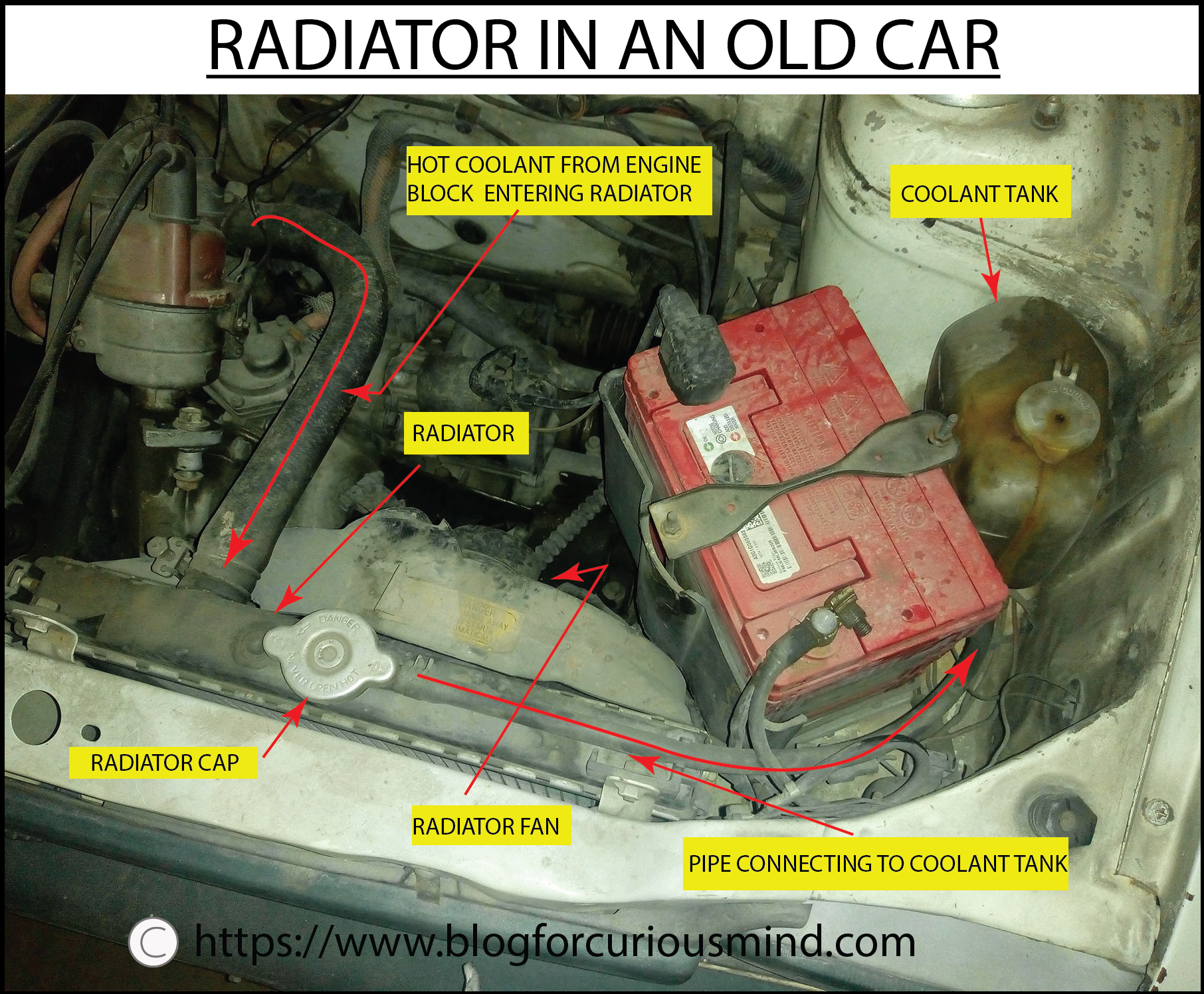Introduction
We know that the car we drive has a radiator to maintain the engine temperature. But do you know the construction of a radiator and how it works? If you want to know more about the radiator, this article is for you. Keep reading.
This article takes you through the following subtopics:
- What is a radiator
- Parts of an engine cooling system
- How a radiator works
- Other applications of radiators
- Symptoms of a deteriorating radiator
- Preventive maintenance for radiators
- Tips from experienced drivers
- Few frequently asked questions.
What is a radiator?
A radiator is a heat exchanger. It exchanges the heat of its hot coolant with the air forced through it by the radiator fan. Let us understand this in detail.
All automobiles including your car have an internal combustion (IC) engine as its prime mover. A working IC engine produces an enormous amount of heat due to the combustion of the air-fuel mix inside the engine cylinder. Also, frictional heat is generated by the reciprocating piston in the engine cylinder.
The exhaust gasses going out of the engine cylinder carry part of this heat. That is why the exhaust pipe becomes hot. The remaining heat is absorbed by the engine cylinder and engine head. Hence they become very hot.
An IC engine is designed to work efficiently at an optimum operating temperature. When the operating temperature increases above the optimum, the engine’s efficiency comes down. In addition, a very high temperature can lead to seizure of the engine and engine damage.
So, it is essential to remove the excess heat from the engine block to maintain the optimum operating temperature. This work is done by the radiator which is a major part of the engine cooling system.
The car engine has jackets cast in the engine block, surrounding the engine cylinders, and engine head. A coolant can be circulated in these jackets to take away the excess heat.
The engine cooling system pumps the coolant into the jackets. The hot coolant coming out of the engine block is passed through the radiator. The radiator transfers the heat from the hot coolant to the passing air. The resulting cold coolant is pumped back to the engine block and this goes on and on.
It is important to note that the function of a radiator is not ‘cooling the engine’. On the contrary, it maintains the engine operating temperature at its optimum level and avoids overheating. An IC engine working at optimum operating temperature achieves higher fuel efficiency, and engine efficiency. And also control the emission within the limits.
Automobiles used in cold places can have a heater core with a blower fan for warming the passenger cabin. The hot coolant from the engine can be flowed through this cabin heater. This gives a dual advantage, the hot coolant gets partially cooled and the cabin warms up.
Parts of an engine cooling system
The major parts of a car engine cooling system are:
- Radiator (heat exchanger)
- Coolant pump
- Thermostat
- Coolant tank or coolant reservoir
- Radiator cap
- Liquid coolant
- Radiator fan
- Hoses, pipes, and fittings
Radiator
The radiator of your car is mounted at its forward, just below the bonnet. This is the best location for receiving the air for cooling. Even in automobiles with rear or center engines, the radiator is mounted at the front. And it is connected to the engine with long pipes/hoses
The present-day cars have radiators made of aluminum. They have an upper and lower tank connected to the radiator core. The radiator core has narrow passageways. This design offers a high surface area for a relatively small volume.
The radiator core is constructed by brazing thin aluminum fins on rectangular cross-section aluminum tubes. These tubes may be flattened aluminum tubes or made by brazing two aluminum channels. The hot coolant flows through the core and gets collected in the lower tank of the radiator.
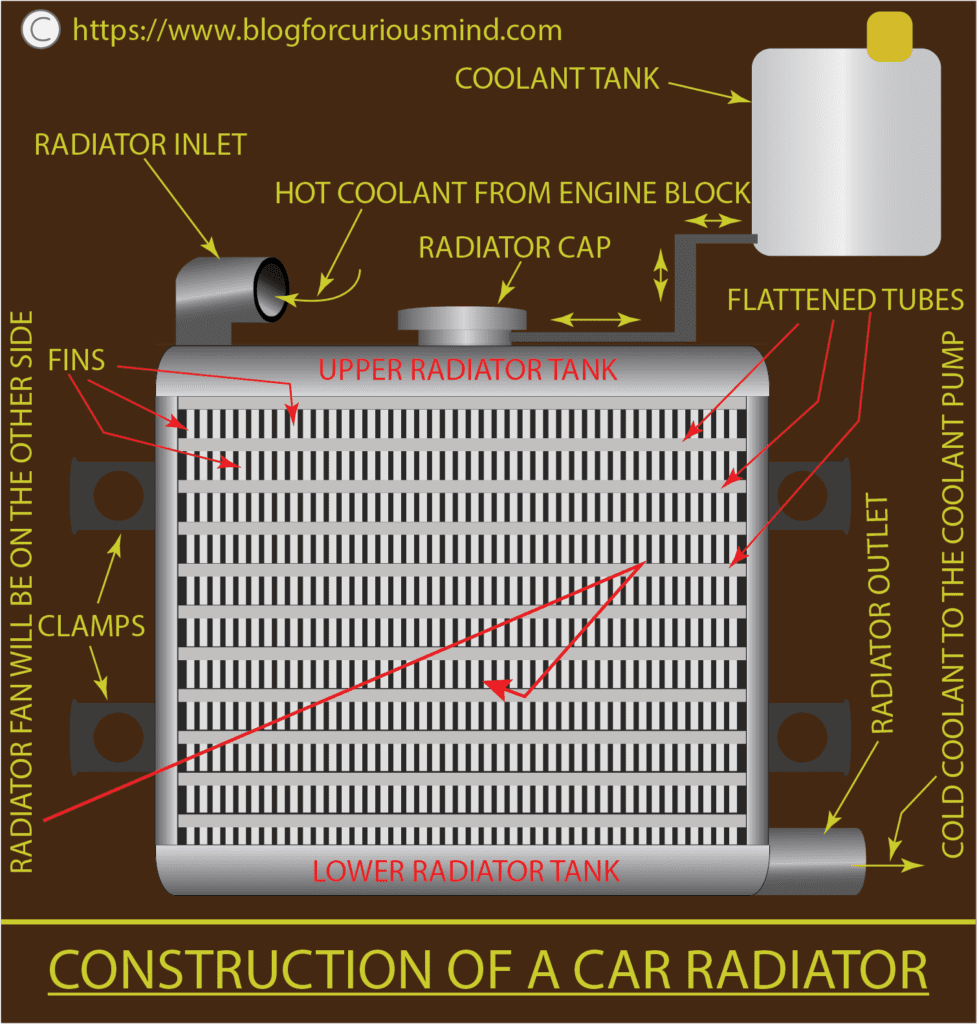
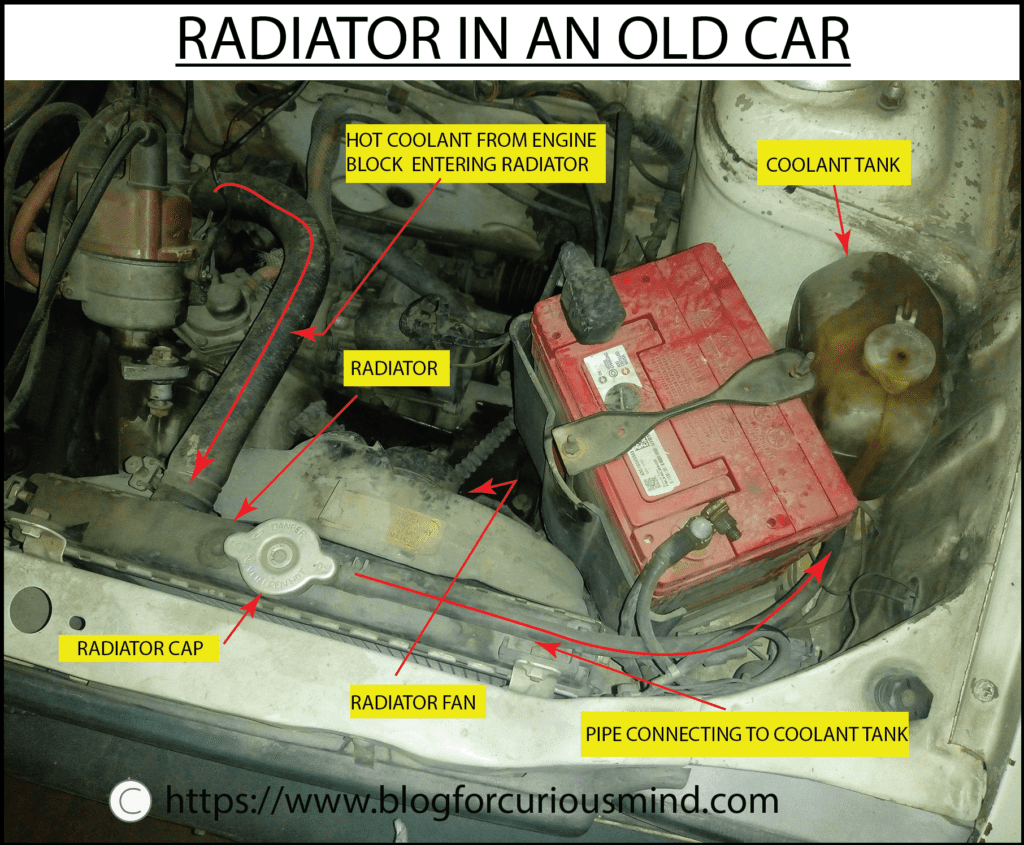
The hot coolant from the engine block enters the upper tank (through the inlet). It flows through the radiator core (tubes) into the lower tank, and into the outlet. The outlet is connected to the coolant pump. The fins on the aluminum tubes dissipate the heat from the coolant and transfer it to the air passing through.
Low-cost car radiators may have plastic upper and lower tanks, and passageways with gaskets to reduce the cost. However, complete metal construction is preferred since they are easy to repair and maintain.
The size of the radiator should be compatible with the engine volume/capacity. A small radiator will fail to maintain the engine at operating temperature and a bigger radiator will keep the engine cool. Both are not desirable.
Coolant pump
This is a centrifugal pump. It can either be run through the engine crankshaft or an independent motor. The coolant pump receives the cool coolant from the lower tank of the radiator and pumps it into the engine block. In some designs, the coolant pump is placed at the exit of the engine block and pumps the hot coolant into the thermostat housing.
Thermostat
The thermostat is placed in the pipe/thermostat housing that receives the coolant from the engine block. The thermostat is sensitive to the temperature of the coolant. In the normal position, when the engine just started from cold, it closes the entry into the radiator.
Consequently, it allows the coolant from the engine block to bypass the radiator and be pumped back into the engine cooling jackets. When the engine starts from cold, the coolant is not hot and does not need cooling in the radiator. Hence the thermostat bypasses it.
This goes on till the engine operating temperature rises above the optimum. Now the hot coolant activates the thermostat to open the entry into the radiator and close the bypass. The hot coolant flows through the radiator, gets cooled, and is pumped into the engine cooling jackets.
Modern car engine radiator-circuit uses a wax-filled thermostat that opens the entry into the radiator after the engine reaches its optimum operating temperature.
Coolant tank or coolant reservoir
The hot coolant entering the radiator can expand due to the high temperature. The expanding/overflowing coolant will enter the coolant tank connected to the radiator. The radiator cap design allows the coolant to move into the coolant tank.
When the coolant becomes cool, there will be a vacuum, and the coolant flows back into the radiator. The coolant tank is a translucent plastic container near the radiator.
Modern cars may have a modified design of the coolant tank and sometimes they are called expansion tanks. However, the function is more or less the same.
Radiator cap
The radiator cap maintains the coolant pressure in the system. This pressure can increase when the coolant becomes too hot. When the coolant pressure exceeds the designed pressure, it can allow the overflowing coolant to move into the coolant tank. When the coolant becomes cool, it flows back into the radiator.
There can be different designs of radiator caps and some may have a built-in pressure relief valve.
Liquid coolant
The liquid coolant in the radiator is water-based. It is a mix of water and additives to prevent corrosion and improve cooling properties. Ready-to-use radiator liquids are available in standard containers and can be purchased.
The coolant has an anti-rusting agent to minimize rusting. The coolant used in cold areas can contain anti-freeze agents to keep it in a fluid state in cold temperatures.
The radiator coolant is kept at a pressure higher than the atmospheric pressure to raise its boiling point. The pressure of the coolant rises with its temperature. Hence, as a safety measure, the radiator cap is designed to allow the overflowing coolant into the coolant tank.
Radiator fan
The airflow across the radiator influences the rate of dissipation of heat from the hot coolant flowing in the radiator core into the air flowing through it. This airflow is controlled by the size of the radiator fan and how it runs.
The design of radiator fans provides methods for its speed regulation viz. fan clutch on belt-driven fans (engine driven fan) or thermostatic switch on electric fans. The intention of the design is to control the fan on/off, fan speed, and increase fuel efficiency.
Hoses, pipes, and fittings
The connection between the engine block, thermostat housing, coolant pump, and the radiator is done using metal pipes, rubber hoses, and fittings.
How a radiator works
Let us start from the beginning and see what happens when you start your car that was parked overnight.
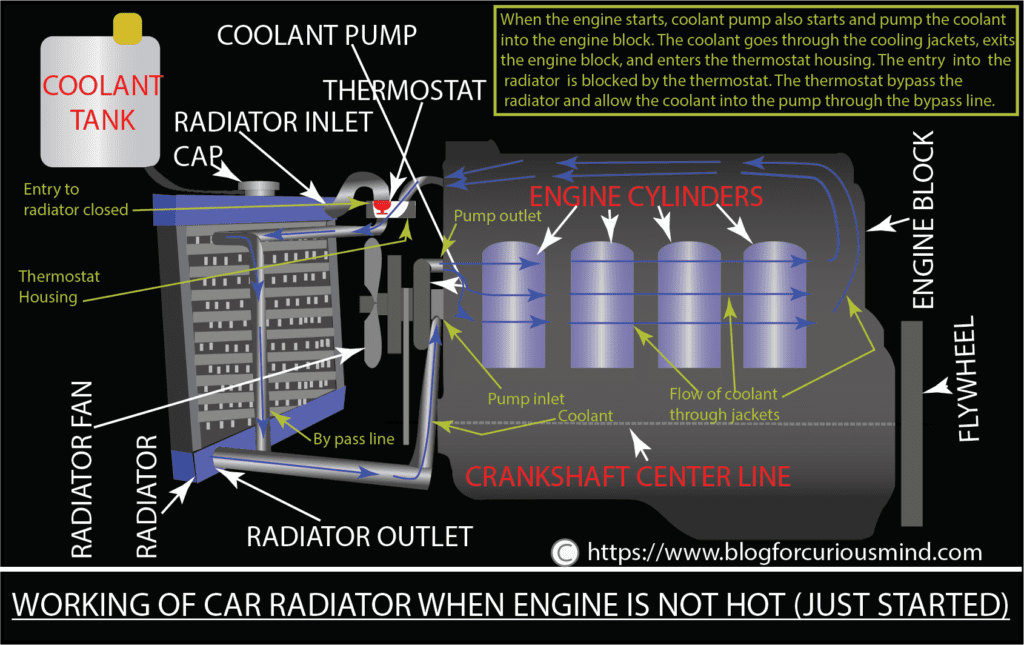
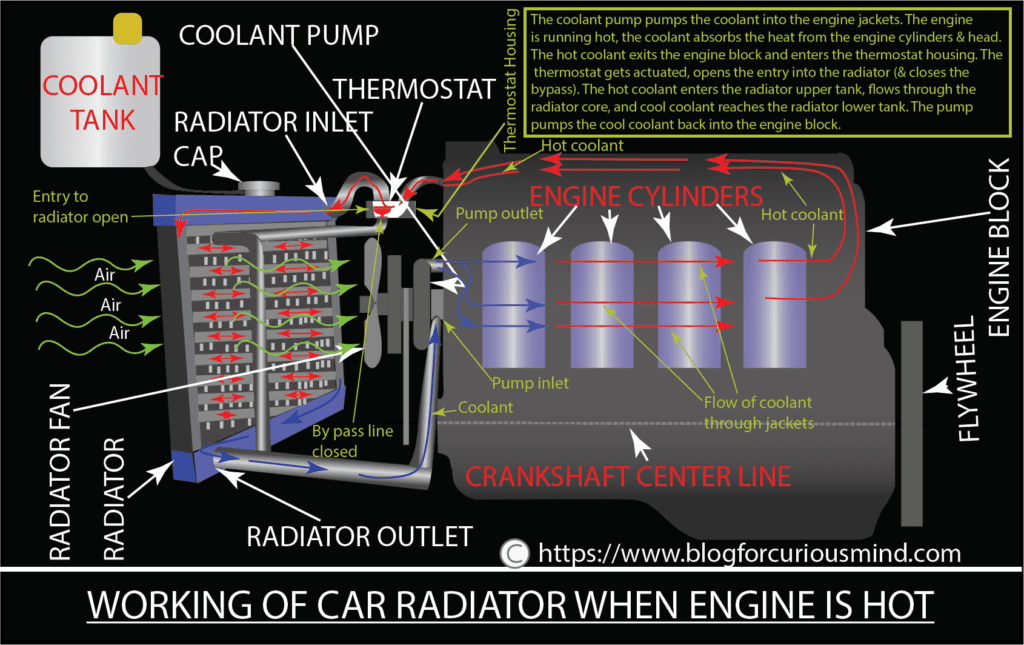
The engine starts working. At this time the engine is cold and the coolant flowing in it will also be cold. The coolant pump connected to the engine also starts working and pumps the coolant from the lower radiator tank into the engine cooling jackets. The radiator fan is not running.
The coolant flows through the jackets surrounding the engine cylinder and engine head, exits the engine block, and enters the thermostat housing. The cold coolant cannot activate the thermostat.
Hence the thermostat bypasses the coolant into the coolant pump inlet to pump it back into the engine jackets. We can say, that the coolant bypasses the radiator and enters back into the engine. Allowing the coolant to bypass the radiator helps the engine reach the operating temperature without any hot spots.
As the engine continues to run, the heat generated by the combustion of the air-fuel mix in the cylinder gradually rises its temperature and the coolant flowing in the engine jackets carries this heat out of the engine. As the temperature of the engine increases, so is the temperature of the coolant.
Once the engine reaches the operating temperature, the hot coolant passing through the thermostat housing actuates the thermostat. The wax inside the thermostat melts, expands, and opens the way to allow the flow of the hot coolant into the radiator’s upper tank.
Simultaneously, the thermostat closes the bypass. The sensors in the cooling system make the radiator fan start and the forced draft created by the radiator fan makes the airflow through the radiator.
The hot coolant in the upper tank of the radiator flows through the radiator core and the fins dissipate and transfer the heat from the hot coolant into the moving air. The coolant becomes cool and reaches the lower tank of the radiator. The coolant pump pumps this coolant into the engine jackets and this process goes on and on.
It is important to note that the function of the coolant and the radiator in the engine cooling system is not to cool the engine. In fact, their function is to regulate the engine operating temperature and maintain it at the designed optimum level for the best thermal efficiency. The optimum operating temperature of your car engine may be around 80° C (176° F).
The thermostat is a proportional device and works according to the temperature of the coolant sensed by it. When the engine is very hot, the coolant temperature is very high and the thermostat allows all the coolant to pass into the radiator upper tank.
When the coolant temperature is not so high, the thermostat can allow part of the coolant through the radiator and bypass the remaining to return directly to the engine. The thermostat does this to maintain optimum operating temperature.
In cars with automatic transmission, the radiator may also be used for cooling the coolant of automatic transmission.
Other applications of radiators
- Many aircraft have propellers driven by liquid-cooled piston engines that use radiators to keep the engine at optimum operating temperature. Since the airspeed is higher than the ground speed of automobiles, aircraft engines do not face any problems during the flight, but face difficulties when on the ground.
- High-end high-capacity motorcycles use liquid-cooled engines with radiators.
- Radiators are also used in stationary equipment that runs on IC engines. Examples are engine-driven electric generators, engine-driven air compressors, etc. Installation of such equipment is done ensuring proper air circulation for the radiator to function.
Symptoms of a deteriorating radiator
A radiator will not fail overnight. It gives many signs of getting bad.
A radiator in the cooling system is designed to manage the engine operating temperature even in extremely hot conditions. So, if you notice the engine becoming very hot it implies there is something wrong with the radiator or the cooling system.
The reasons for a nonperforming radiator can be:
- Insufficient quantity of coolant in the system
- Leakage from hoses/pipes
- Thermostat not working
- Fan not working
- The radiator cap is unable to pressurize the system resulting in an overflow of the coolant
- The radiator may lose the coolant due to leakages or cracks in the piping or repeated overheating problems.
Major overhauling of a radiator and cooling system may cost you dear. To avoid costly repairs, notice the signs of a deteriorating radiator/cooling system and take appropriate timely actions. The visible symptoms can be:
- Repeatedly getting the feeling of an overheated engine
- Smoke or smell from underneath the hood of your car.
- Coolant is collected under your car. You cannot miss this since the coolant has a distinct green color.
- Erratic reading on the gauge showing temperature
When you notice a symptom of a malfunctioning radiator and cooling system, look into it and get the expert’s help.
Preventive maintenance for radiator
The saying ‘prevention is better than cure’ aptly applies here also. Do the following to enhance the life of your car radiator cooling system.
- Radiator hoses are made of rubber and can crack after a certain period. Look into the owner’s manual and replace the radiator hoses as recommended.
- Check the coolant level at known intervals and if there is an abnormal loss of coolant look for leakages.
- Get the coolant flushed from the system after every 20 to 25000 miles run or as recommended in the owner’s manual. This flushing will remove any rust particles and contaminants in the system.
Tips from experienced drivers
If you are driving uphill in hot weather, the radiator may sometimes fail to manage the optimum operating temperature of the engine and the engine becomes too hot. Under such circumstances, the needle showing the temperature can hit the maximum level. It is better to park the car in a shade and open the bonnet to help the engine get cooled. You can start your drive when the engine is sufficiently cool.
Do not forget to inspect the radiator cooling system. Take the help of an expert to set it right.
Your car engine can stop working when it becomes too hot and you are forced to park your car on the roadside. But, never rush to open the radiator cap to check what is happening. The hot coolant will be at high temperature & pressure and using force to open the radiator cap can result in spurting of the hot coolant on your body.
Do not forget to check the coolant level in your car cooling system before going on a long drive. Top up the coolant if required. Never add water to make up the coolant level unless it is an emergency and you are stuck up on the road. You will never be sure about the quality of the water.
Frequently Asked Questions (FAQ)
Can a car run without a radiator?
If you drive a car without a working radiator, it runs for a few meters and starts getting overheated. Allowing an engine to get overheated can cause serious accidents and damage to the engine. So, it is not safe to drive a car without a working radiator.
Which coolant should I use for my car?
The best way is to purchase a pre-mixed coolant recommended for your car. Doing this will save your car from rusting, overheating, etc. If you live in a cold area select a coolant with an anti-freeze agent recommended for your car and the climate in your area.
What is a car radiator?
A car radiator is a heat exchanger and is part of your car’s engine cooling system. The IC engine in your car works by the combustion of air-fuel mix in the engine cylinder and produces an enormous amount of heat.
A coolant is passed through the jackets surrounding the engine cylinder and engine head to absorb the excess heat and the radiator cools this hot coolant before pumping it back into the engine. A radiator helps to maintain the engine operating temperature at the optimum level.
Why a radiator is important for your car?
A radiator is an important part of your car since without a radiator the engine temperature shoots up beyond control and the engine will get damaged. If this heat is not controlled, the engine components become hot and they can expand or distort and eventually stop working. All these can lead to serious engine damage and accidents.
Conclusion
In the preceding paragraphs, we had a detailed discussion on the construction of the car/automobile radiator, how it works, and related topics. Hope this article was able to make you a little wiser about your car radiator.
You may want to read the article What are FWD, RWD, AWD, and 4WD drives of a car and their pros and cons
Caution
This article is for educational purposes only. Do not consider this as a guide or manual about the radiators. If you notice any problem with your car radiator, study your owner’s manual and consult an authorized mechanic to get the problem solved.
References:

